1 - History of The Island Yacht Club
Updated 1991
This booklet was loaned to us by Jane Parkin and transcribed by Janet Penn.
~~~~~~~~~~~~~~~~~~~~~~~~
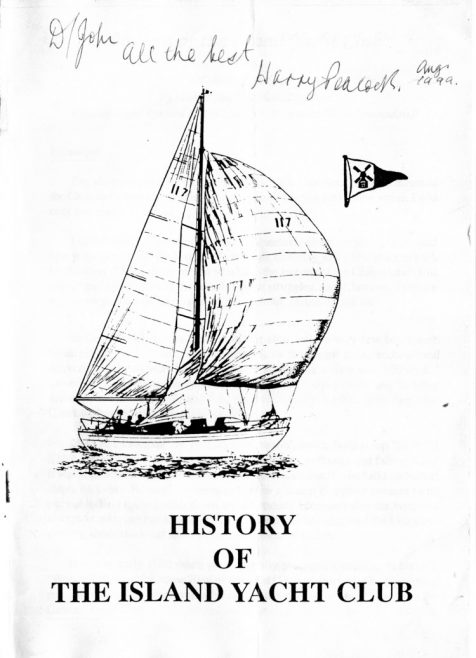 With ‘Echoes of the Past By Arthur Rapkin, Hon. President (Updated and revised to 1991 by John Brantwell (Past Commodore))
With ‘Echoes of the Past By Arthur Rapkin, Hon. President (Updated and revised to 1991 by John Brantwell (Past Commodore))
Foreword
I’ve always been 100% for the idea of regular Newsletters for Members of the Club and when I was approached to contribute towards a new series, I was only too happy to oblige.
I understand it is planned to make it a quarterly effort, so with that in mind I propose to write on the history of our Club, covering just a few years in each publication. I hope many of you who have the interest of the Club at heart will enjoy hearing about its birth and subsequent struggles, and if, later on, there are any items you would like to know more about, please do ask me.
A. Rapkin
Before we decided to form a sailing club, only a very few boats used Smallgains/Oyster Creek, and, of course, in the frugal days, second-hand converted lifeboats were luxuries. The only real class cruiser was “RENE. K.” owned by J.Lawrence Senior, other than Thames barges delivering building materials to the Canvey Supply Co., and Leigh Bawleys off-loading fish, – the Creek harboured only a handful of craft.
In 1930 I swapped my 16’ Scow for an old Broads-built sloop “NORTH STAR” and with a 3′ keel began to learn all about sandbanks and falling tides! It was soon after that I became acquainted with Ossie Smith who had a converted ship’s lifeboat. He used to overload it with a dozen complete novices (who proved to be a cycling club down from London) – consequently the boat was always in some sort of trouble and it was then that he suggested the idea of us pooling ideas and local knowledge in the form of a club.
It was in early 1936 when we eventually managed a meeting in his cafe ” Woodville”, at which some 20 of us attended (12 of whom were Ossie’s cycling pals), but never-the-less it was a friendly gathering and we decided to form the Canvey Yacht Club.
Ossie Smith was appointed Secretary, I was made Treasurer, and A. McCrerie a reluctant Commodore -I say reluctant because he was a very quiet and retiring man, but we felt he should hold the ‘Office’ being the owner of the only good jetty with a hard and a floating cafe, which he offered as a temporary clubhouse.
By the end of 1936 we had about 50 members and were able to sponsor our first Dinner & Dance, but the progress was only made possible by the kindness of J. Lawrence (Senior) and Mr Price Powell, who had started us off with a small donation towards our funds during that first year. Membership fee was 7/6d (37p today).
Easter 1937 saw us started off with new enthusiasm; our funds were now strong enough to launch out to buy our own badges and burgees; at that first meeting it had been agreed to use Blue on Red/White in honour of 1935 being Coronation Year – the Windmill was used as an emblem in memory of the Dutch who had been called in to save Canvey from the sea encroachment, and finally the Essex scimitars included because of our geographical position.
Later, a new member, Mr Phipps, kindly presented us with a small 35′ lighter which had been converted for a then famous illustrator for “Yachting World”, situated in the saltings near the present sluice gates. It was our first clubhouse and enabled us to get together for tea parties and discussions.
Despite the menacing clouds of War, 1938/39 were very successful for us, the Bank Holiday Rallies attracted 80% support as did our first efforts at Handicap Racing.
By the 40’s we were beginning to suffer from the call-up, and as our co-founder Ossie Smith had already left the Island for business reasons, it was agreed at the A.G.M., that for the time being Mr Rapkin should combine the offices of Hon. Secretary and Hon. Treasurer. However, the War took its toll of our Officers as most of the younger men were called up:- luckily a popular new member, Mr Oddy volunteered to take over the Secretary’s job and Miss L. Rapkin filled in as Treasurer, as my call-up became imminent.
Finally, before I left in February 1941 I managed to call an emergency A.G.M. and advised making the running of the Club a sort of Coalition, with Mr Oddy at the head until the War was over, but only 18 months later I received an urgent request from my family and Mr Oddy, to try to get a 48 hour pass to attend an A.G.M.
A new member, rich, but must remain nameless, had been able to persuade enough of the very few members left behind to call this A.G.M. on a Sunday at the Casino Ballroom!! I put these exclamation marks purposely, because the older ones among you will remember that it was the largest ballroom in Essex.
When I arrived there on compassionate leave(?) imagine my disgust to find only about 20 anxious wives and mostly female members present in this vast hall, facing a long green baize covered table with about 5 of the Committee behind it, looking completely ridiculous. Although I was able to thwart the takeover plans of the aforementioned ‘yuppie’ by pointing out that a coalition arrangement had been agreed upon and with 80% of our male members away in the War effort, we had no logical right to alter the Club in any way until the majority were demobbed and had joined our ranks again. This won the day, but not before a vote had been put and passed, to alter the Club name to the ISLAND Y.C. instead of Canvey Island Y.C., on the excuse it was rather a dowdy unknown place for a Club(?) needless to say this had to stay, as when the first peace-time A.G.M. was called it was pointed out that the new name had been registered at Lloyds for some 3 years and it was agreed not to alter it back because of any misunderstandings and, of course, waste of money involved (our stock of badges and ties etc. had run out during the War and the new I. Y.C. ones purchased). So, if any of you interested members would like to see a CYC. badge 50 years old, just ask me.
I must apologise for writing at length about this period in our history, but, once we had our first peacetime A.G.M. the results and support proved we were right in leaving important business until then.
Of course, back on Canvey during the 1940-46 hiatus, things were not good for boating, – only craft allowed to stay afloat were registered for fishing, but some of us managed to get a licence, although we hated fishing. Even then we were limited to a mine-cleared area from Southend Pier over to the Mid Bligh. (I used to get out when home on leave in a borrowed T.E.O.D. but once got chased by a Police launch for questioning – luckily I knew the sandbanks better than them, and escaped over the mud flats before they ran aground). On hindsight it was a very silly action to risk it, as only 2 months later a fishing bawley from Leigh on Sea was blown out of the water by a mine just off the Yantlett Creek.
In the next episode I promise to write more cheerfully – once the winds of War had blown away and we were back in civvies, the Club just bounded forward, full of new enthusiasm, although our bank balance was only £200.
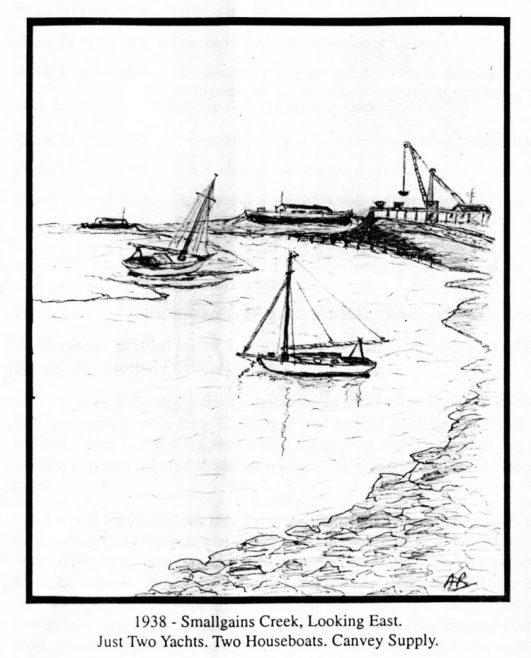 1947 Once again we were able to start our various activities, and races and rallies gradually attracted more support – the August Rally to Queenboro and Harty Ferry drew some 20 Craft and the October A.G.M. numbered over 60 persons – not bad for our first Peacetime meeting.
1947 Once again we were able to start our various activities, and races and rallies gradually attracted more support – the August Rally to Queenboro and Harty Ferry drew some 20 Craft and the October A.G.M. numbered over 60 persons – not bad for our first Peacetime meeting.
Despite one of our worst Winters with the Creek frozen right across the 1948 Season started well with fortnightly Rallies but the great step forward was the purchase of an ex-Thames barge “Louise”. This proved a real asset, it was moored next to the old Tea Rooms clubhouse and provided us with storage space and a social venue for parties and afternoon teas, etc. This Season was also our first real move to encourage local sponsors for our racing.
Sunnyside hotel (where my Hotspots Band was resident at weekends) gave us a Challenge Trophy and the new “Canvey Chronicle” were encouraged to put up another Cup for our racing in opposition to one from Fred McCave’s “Canvey News”. The one black spot on the horizon was a Government backed plan to get rid of all houseboats with a view to damming Smallgains Creek. Naturally the Committee were alarmed for our future and many Councillors and surveyors sympathetic with our progress were enlisted on our side.
I consequently drew up an alternative plan to use lock gates in the proposed dam which could provide a large inland lake for boating and swimming etc. in the proposed cut-off area of some 1/2 mile of the Creek, but like all good ideas it disappeared later in a morass of Council mis-management. Today, if that plan had been accepted, the Council could have had a natural Marina bringing in an income of £1000’s per annum, but later on you will see how the powers that be, ignored the plan and made a wasteland in its place. The year ended in grand style for our Annual Dinner & Dance at the new Sunnyside Hotel with membership touching the 90’s mark.
In 1949 we started well with a big step forward by becoming affiliated to the yacht Racing Association (now the R.Y.A.) and in case you are interested in figures, our fees were set at 15 shillings for subs. 5 Shillings entrance fee with members still in the forces free. Apart from the increasing number of races and rallies three innovations were launched – our first Marine Photograph Competition held in the new barge H.Q. – our first entry in Canvey Carnival, and, because of increasing support, we moved over to the Bay Country Club for our Easter Dance complete with “Lovely Legs” and “Knobbly Knees” competitions! but loyally returned to the Admiral Jellicoe for our Annual Dinner & Dance.
In the Canvey Carnival we won a 3rd prize – the late Lily Rapkin won 1st prize and a camera in the Photographic Competition judged by an M.R.P.S. from Ilford Ltd. and the most consistent racing winners were Roland Prout in a 14′ International and John Fisk in a Firefly.
1950 was outstanding for more racing with new sponsors and our first Channel crossing for five of our craft all of whom returned safely.
A new venture was a nautical film show put on at the Admiral Jellicoe in aid of the R.N.L.I. – you want to know the films we hired? Captain Courageous and Bligh of the Bounty! – we were quite seasick after that 3 1/2 hours of sea thrillers! Progress was still steady and we ended our Season with 120 members and 50 craft.
1951 Must be one of the highest spots for this Yacht Club; let me explain why:- Every Christmas a few of our more hardy sailors had been in the habit of taking Christmas Fayre to the Keepers of Chapman Lighthouse and by chance we learnt it was their Centenary of the Lighthouse. When suggested to the Committee that we should put on a big celebration it was agreed 100% and plans swung into operation. The B.B.C. was interested and the local Sea Rangers and Canoe Club asked to be included; there was no affiliation with the mainland clubs in those days, so despite their interest we voted to go it alone.
Saturday June 23rd was the “big day” – it started a bit dull and rough but with a better forecast the Trinity House Brethren gave us the necessary permission to go alongside with the 3 club representatives, the B.B.C. and Pathe Newsreel cameramen. North Star I was also allowed to land after leading a wonderful fleet of Club Craft and Canoes in an agreed figure of eight round the lighthouse. Gifts were presented to the Keepers and a special plaque of commemoration was given to Trinity House, which is still at the London Headquarters today.
A special tribute was paid to Mr E.E.O. Lawrence, father of John Lawrence, whose lovely motor yacht “RENE. K.” had acted as host craft to all the Press and Officials picked up at the PL.A. jetty in Holehaven. The only ironical part of it all was that something which had taken us months of careful planning was disposed of by the B.B.C. and Pathe Newsreel in approximately 2 1/2-3 mins showing! In July we had another first at the Admiral Jellicoe when the Chairman of the Council opened our Arts & Crafts Exhibition which created a lot of interest among the general public, this was followed by a Football Match on the mud at Thorney Bay, both of which were in aid of the Seamans Fund.
Being Festival year the Royal Yacht Britannia was due to pass Canvey with the Royal couple aboard, so once again we launched a Sail Past pageant and a message of goodwill was flashed from Labworth Cape by an ex-navy member and duly received and answered by Her Majesty.
So ended our best year ever bringing good publicity to the Club and to Canvey Island.
1952 was rather an anti-climax after all the high spots of ’51 but one outstanding feature was the Thorney Bay Regatta. We tied up with Col. Fielder of the Holiday Camp to stage a weekend of activities in Thorney Bay (for your information up to 80 years ago it was marked as Dead Man’s Bay!!)
We produced a mud football match kicked off by the then Carnival Queen; a water polo match as the tide flooded in; a race for the New Thorney Bay Cup; and finally rounded it off with a big Carnival Dance in the Camp Ballroom; the weather was hot so everything went as planned.
1953 This was to be our first setback apart from the War Years. On Saturday February 1st came a big surge from the North Sea which flooded Canvey and all low lying land on the East Coast. On Sunday several fishing bawleys from Leigh came over to help and took off many stranded residents and took them to the relief centres in Benfleet. We used our dinghies to ferry them over and try to rescue people still left behind by the Army Lorries; but by Monday most of the flood water had receded and thankfully the high tides never returned. I managed a couple of days off work, so helped the Army and other volunteers to sandbag all the gaps in the back sea wall. The Club barge gantry was damaged and we only lost one boat, due to overloading with sand and cement – all the others rode out the flood O.K. – but on the human side we lost one old member and his wife drowned and another local Sea Scout Master died later from the intense cold.
On the credit side we appealed to the R.Y.A. for some help and a cheque for £25 was gratefully received. Once the Season started again racing and rallies went ahead as scheduled but the year ended unhappily for my family as our Thames Barge Houseboat “Old Upton” once “Black Duck of Rochester”, which had been wrecked by the flood, had to be destroyed, so on November the 5th the local children were invited to the burning of the poor old girl – she blazed for 2 days and nights. “Old Upton” had been the scene of many birthday parties, etc., for Club Members over the years and was a sad loss.
1954 showed, steady progress with regular tea-parties on the renovated “Louise”, with as many as 50 present, and remember it was only Tea! no licence aboard, even the christening ceremony was performed with a smashed bottle of Tizer! Perhaps the high spot was the quick return to social events after that Flood misery; on New Year’s Eve we had a Fancy Dress Ball at the Admiral Jellicoe with 150 present ALL in Fancy Dress.
1956/7/8 I must apologise for a scarcity of news for these years as some kind person took away our Scrapbook for that period, but I can remember that progress was very good. We encouraged the advent of the “Canvey Chronicle” starting on the Island and duly received Racing Cups from them, the new “Yachts & Yachting” magazine started in Southend. My old “Nth. Star I” was sold and replaced with the new Dauntless Nth. Star II, which, aged 31 still sails regularly. At the end of 1958 we purchased the present land from the Lawrence/ Clarke Estates, and immediately looked round for a temporary type building. This we acquired, and after hectic foundation work, with a hired mixer, it was erected.
 1959/60 Voluntary work, under supervision of a builder/member had it ready for the Spring and in May ’59 the then Harbour Master from the P.L.A. officially opened it for us. But with increasing membership it was obvious that it would soon burst at the seams, (for one popular film show we had 60 people packed inside with another 30 odd watching through the windows,) but of course, the extra attraction must have been our first real licensed bar. Because of the increased members we had to move to the mainland for our Easter and Annual Dinner and Dance.
1959/60 Voluntary work, under supervision of a builder/member had it ready for the Spring and in May ’59 the then Harbour Master from the P.L.A. officially opened it for us. But with increasing membership it was obvious that it would soon burst at the seams, (for one popular film show we had 60 people packed inside with another 30 odd watching through the windows,) but of course, the extra attraction must have been our first real licensed bar. Because of the increased members we had to move to the mainland for our Easter and Annual Dinner and Dance.
1961 This was to be our next stepping stone into future prosperity. Being our Silver Jubilee year the Committee planned to make Canvey sit-up and gasp. In the next instalment I will give you all the wonderful details.
We started off our Silver Jubilee year with a Tree Planting Ceremony at Easter, when the Officers and Committee each planted a conifer, with their name attached, on the outside boundary of the Clubhouse. Today, with extensions and improvement etc., only six remain.
We chose Whitsun weekend for the celebrations and were blessed with hot sunny weather and a big support, over 300 programmes being sold.
On land we staged the usual Children’s Sports, followed by Tug-of-War, Greasy Pole, etc., for the adults; but everyone was catered for with side shows and a real live Fashion Show complete with mannequins and background music in a special marquee. At sea, thanks to an afternoon tide, we held swimming races and comic events, rounded off with a dressed ship “Sail Past” up at the Point.
It was officially opened by the then Chairman of Canvey Council, and closed in fine style with a big Dinner and Dance at Garons of Southend, with several Commodores of local Yacht Clubs sharing the celebrations.
1963 This was by no means an anti-climax as our increasing membership forced us to expand part of our “new” clubhouse with an extension, originally designated the Cadet Room (now our Dart Room area) but once finished we promptly filled up the extra space with popular dances and a highly successful Black & White Minstrel Show.
1964/67 I have had to group these years together because my scrapbook had been stolen from the Clubhouse, but my photographic records show they covered a lot of activity and work on moorings and fittings, etc., but the high spots were all achieved by the Sailing Section. Our Mirror Dinghy Fleet was uplifted by the new membership of the late Alf Buxton whose helmsmanship encouraged our members to increase, culminating with his winning of the European Championships in Sweden in 1967.
1968 This was another good year on the sailing side; we actually gained 3 firsts at the Nore Race, and our Mirror, sailed by R & B Walsh, slipped to 2nd place in the European Championship as Alf Buxton was unable to defend his title, but he won the Open Championship. The saddest event that year was the closing of Benfleet Creek to Holehaven by the erection of the Bridge, – John Lawrence took a contingent of Councillors on that last trip round the Island and N. Star followed with some of our officers. This year also marked the tie-up with Hurlingham Y.C. of Putney who, in appreciation of our rescue of some of their fleet of boats off the rocks on Canvey Sea Front in a southerly gale, presented us the inscribed bell (still in the Clubhouse today). We maintained contact with them in mutual visits for many years and anyone making the trip up Thames who calls in their waterside Clubhouse would, I’m sure, be made very welcome. (I visited them 2 years ago with a plastic rope round my prop, and it was cleared by them without my help!) To finish off the year a Rum Mirror Race was held on December 21st with 14 Starters! !Brr!
1969 This was another good year for sailing – the Open Dinghy Championships held round the East Coast, came to Canvey for one meeting and we had the pleasure of seeing the Champion Reg White from Brightlingsea show us how it is done. Ken Pearce, a local top helmsman visited us with a film show of his efforts in the Transatlantic Race, and we signed on a new member who later became the Chancellor of the Exchequer and presented us with the Amery Cup for Cadets.
The saddest note of ’69 was the passing of our old friend Mr N. Phipps who, you will remember, gave us our first floating Clubhouse in the early days. He was always 100% for the Club and honoured us at the end by asking me to scatter his ashes in the Thames Estuary where he had enjoyed sailing with our Club. This was made possible by the kind co-operation of John Lawrence who took us and the local Vicar out for the ceremony in his M/C “Taurus”, needless to say on the way back the ship bar was opened and we toasted a grand old man of the sea in a way he would have most appreciated. It was during this year that a new 11′ 6″ “Turtle” Class Dinghy was designed and built by Thames Marine (builders of the Snapdragon range of boats) and introduced into our programme but subsequently it proved to split our Mirror fleet and cause its decline in years to follow.
1970 It was at this period that our Dinghy Section was at its best, when the Members rebuilt and improved the dinghy compound and slipways, which have lasted well until today. The Turtle had, by the end of the Season, sold well enough at home and abroad to stage their first European Championship at Canvey with 25 entries; after several races over the weekend we took 2nd, 3rd, 4th, and 5th places.
1971/74 Once again most events were in Sailing Section but one great step forward was our membership passing the 300 mark for the first time.
The Turtles and Mirrors continued to win many championships around the coast including the European Turtle Title which was brought back to Canvey by the Walsh family. At this period activities of the Club were so varied and many, that our Mr V. Senatore was appointed Press Officer, a post which he has held with excellent service up to the present time. Also, this year marked our entry into the InterClub Association, which represents all the local Yacht Clubs.
A sad note on which to end the year was the demise of our loyal Treasurer, Miss Lily Rapkin; from 1937 she had kept us on a tight rein and left us with property and good bank balances.
In her memory £450 was raised to buy a speedy rescue boat, which with the help of Club funds resulted in the craft so active in all our races today. The Committee was kept busy fighting off the plans of the Anglian Water Authority to dam the creek where our present slipway lays, but we won in the end and it was defeated.
1975 This year started off with the launching ceremony of the Rescue Boat “The Lily Rapkin”; which the members had financed in memory of the Club Treasurer for 40 years, (actually, at the pre-Cocktail Party – the boat nearly floated off in an alcoholic sea!).
Racing was increasing with good support – most dinghy entries numbered approximately 12/15 and the Cruiser section drew 20/25 starters, but the great step forward was the application to start stern-on moorings to replace the 30 year old centre-creek chains and buoys. The Season ended with our first Annual Dinner & Dance at the Cumberland Suite, Westcliff, which, despite several try-outs at alternative venues, is still our favourite choice today.
In 1976 the Rescue Boat really earned its name when 3 lads were cut-off by the rising tide on the Ray Sands – luckily we managed to snatch them off with only 10/15 minutes to spare. By now, most of our plans for progress were well in hand thanks to the great efforts of the Planning and Mooring Committees. A new Dinghy compound was built and followed up by an excellent slipway which in turn led to part of the saltings being reclaimed for laying-up facilities.
1977 was to be another milestone in our history, as we launched into a Grand 4-day celebration of H.M. Queen Elizabeth II’s Royal Silver Jubilee. In these four days we held Fancy Dress Parades,Water and Land Sports, Barbecue with Fireworks, a Cocktail Party, rounded off on Tuesday June 7th with a Sail Past (in the rain) and a Commodores’ Tea Party and Prize-Giving. Nearly 400 programmes were sold and all profits went to the R.N.L.I.
What better way for me to fade out, being then retired temporarily at 66, I decided to retire as Commodore and was made Honorary President, leaving John Grosvenor to take over the helm after 7 years as my Vice Commodore. The next 2 years proved very hard work for all the Committee and Officers, as Planning was frequently obstructed by Local Authorities, the Council and on the odd occasion by local residents.
By 1979 a new Commodore, John Bramwell, took over and he too had a hard time with the Authorities, especially with the Anglian Water Authorities on the raising of the Sea Wall, at the beginning of his term of office, with the unstinting efforts of Sheila Stammers, arrangements were made for members to plant some 150 young trees around the perimeter of the tipped areas of the saltings and alongside the public footpath leading to the eastern end of the Point. Regrettably after some 6 months the majority of the trees had been stolen – including all the conifers – but 4 trees still remain to this day.
In 1979-80 the laying-up compound was finished, and for the Winter months many craft were able to enjoy the privilege of working on their boats in ideal conditions. During the previous summer months work had commenced on the first of the stern-on moorings.
On the 28th April 1980, in the early hours of the morning, one L.A.J. Mitchell, who traded as Merlin Marine (and many other names – see Evening Echo, Monday 21 st October 1983) erected a compound and installed a caravan on part of the area which the Club had infilled to the West of, and adjacent to the public footpath.
Mitchell laid claim to virtually the whole of the saltings at the Point, including the area that we had tipped, on the basis of acquiring from one D. Baker a possessory Title to the whole area. The only area excluded was that upon which the Club’s laying-up compound was constructed, the slipway, and the area between those parts and our road to Point Road. He of course did not lay claim to the road. Included in Mitchell’s claim was a large area of the River Thames and a small area of the shingle/sand beach at the eastern end of the Point, being one of two small parts of the Point not owned by the Club. This other part is vested in Castlepoint Council, but it is now thought that this area has reverted to mud-flats.
Charlie Blanchard, a Club Member for many years, reported Mitchell’s activities to John Bramwell at his office at 9.30 am, he immediately ‘phoned Malcolm Hockett, the Clubs Rear Commodore who was employed as a litigation executive by a large London firm of solicitors. Proceedings were immediately commenced against Mitchell in the High Court in London, and within 24 hours an injunction was obtained against Mitchell to preserve the status quo until a full hearing could take place with both sides represented. The plaintiffs in the action were the Club’s Trustees – Basil Black, Vera Lawrence and John Bramwell, and the senior flag officers. John Bramwell was also Commodore, Allen Brooks Vice Commodore, John Brinkman Rear Commodore, together with Malcolm Hockett Club Secretary.
At that time little thought was given to the length of time the court action would take – in fact it took over four years before the Club won and Mitchell was made bankrupt.
Pending a full hearing of the case Mitchell was ordered to remove all of his installations. However even in these first few days parts of his compound fencing had been pulled down and the caravan pushed over the edge of the tipped area onto the saltings by person(s) unknown.
At the Bankruptcy Court, which followed the Court Action relating to the ownership of the saltings, Mitchell failed to satisfy the Judge with his answers at two hearings of his public examination which was adjourned sine die. To this day he remains an undischarged bankrupt by virtue of this and other exploits. Prior to the bankruptcy many meetings took place with Mitchell and his lawyers attended by John Bramwell and Malcolm Hockett.
As a result of the bankruptcy a Trustee was appointed and Malcolm Hockett was able to negotiate a settlement with the Trustee which the Court approved dismissing Mitchell’s claim and transferring to the Club any rights he may have had in any part of the area he claimed. This included the area which the Club had not previously owned. It also gave the Club an option to purchase for £1 the concrete barge, which option the Club exercised.
Mitchell further has to pay the Club costs for which the Club is a creditor in the bankruptcy for £30,000. (The Club had only to pay Malcolm’s firm just over £6,000 in respect of monies paid out by them to Austin Allison, the barrister who so ably acted for the Club.) THUS THE FUTURE OF THE CLUB WAS SECURED.
In November 1981, John Brinkman became Commodore, but sadly his death terminated his reign, before it had ended. Whilst in charge he helped to improve our Clubhouse with several innovations:- the ships wheel centre light, the hi-fi system, and the wind vane and indicator (he and I had seen this idea in a very rich Yacht Club in Nieuport, Belgium, and we vowed we would be the first Club in the Association of Yacht Clubs to install it, and we were).
Our Vice Commodore, Brian Turner took over the remainder of John’s term of office, and then served as Commodore for the next three years. During Brian’s terms of office, as Rear, Vice and then Commodore, he was instrumental in revitalising the racing activities of the Club to such an extent that we were probably the most respected Club in the Estuary, particularly in small cabin cruisers. Later on the Cadet Section slipped back in numbers with so many passing into full membership age. 1986 was a very busy year for Brian, reaching a climax in the Whitsun Weekend when the Club celebrated its Golden Jubilee. Celebrations once again included dances, sport, racing and at the ‘Supper’ variety acts by the girls and some of the men in various guises. The highlight was our 20th Annual Whitbread Race, which the Brewers acknowledged with Gold and Silver trophies and special pennants.
The ultimate Sail Past of dressed ships was the envy of all our sailing club friends on the mainland, and even the Marine Police joined the parade.
Once again our loyal supporter over many years of struggle – Sir Bernard Braine (father of the House of Commons) was our Guest of Honour, and local firms like Halcon and Prouts gave us strong support.
Brian’s term of office finished in November 1986, a truly golden year for him. John Bramwell again took over the helm as Commodore, and most of you now in the Club will know better than I of the hard work all the Sub-Committees have put in under his banner. During these years the Club’s Membership increased to some 500 plus Members, the number of stern-on moorings continued to grow, the bottom bay of the slipway was concreted, and after much deliberation a second tractor and a boat mobile lifting out trolley were ordered, this again enabled the Club to give members the increased facilities they required, when they were needed.
Regrettably during 1988 the death occurred of Ossie Smith, who with Arthur was the Co-founder of the Club.
In November 1989, Ray Chuter, previously the Club’s Vice Commodore took over the reins as Commodore and the development of the Club’s facilities at the Point continued. Full planning consent has now been obtained for the proposed Clubhouse and Outline Planning Consent, for residential purposes, has been obtained in respect of the land where the Club is at present situated in Wall Road.
It is interesting to note that due to the foresight of Club Members, Canvey Point Saltings was purchased on 19th October 1961 for the princely sum of £405, from the Trustees of the A.M. Clarke Estates (E.E.O. Lawrence, W.A. Squier and T.W. Squier).
In 1966 the Club commenced to formulate plans for its development, and in 1968, Outline Planning Consent was sought and obtained from Canvey Island U.D.C. for the full scale development of the area. Relevant consents were also obtained from the P.L.A. and A.W.A. Since then, the Club has sought and obtained detailed Planning Consents in respect of various parts of the original Consent, and of course they have still adhered to the original concept.
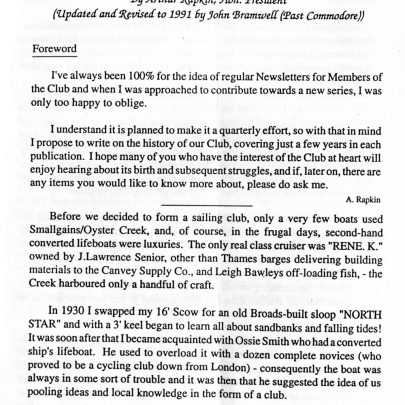


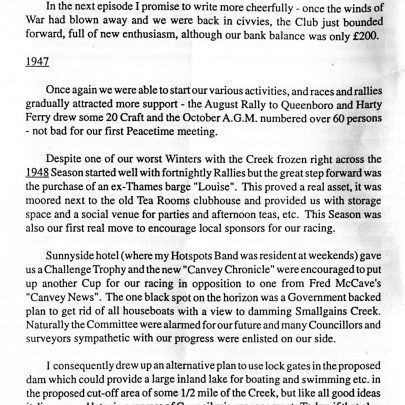
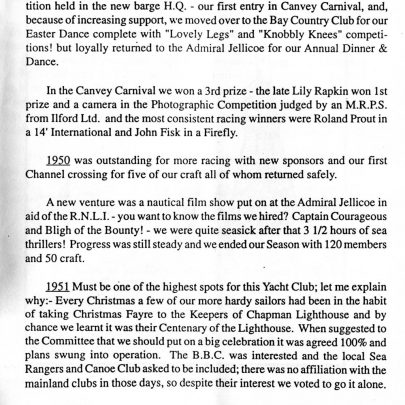

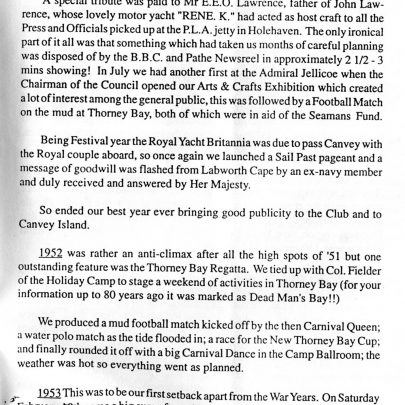
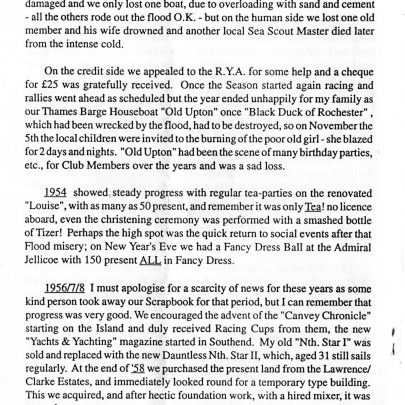

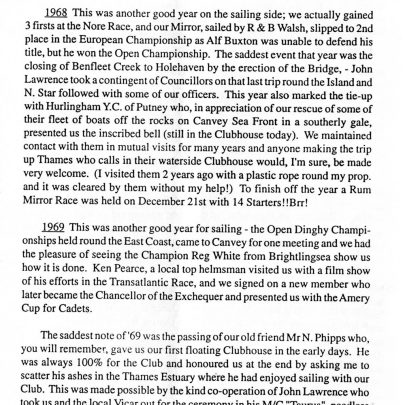

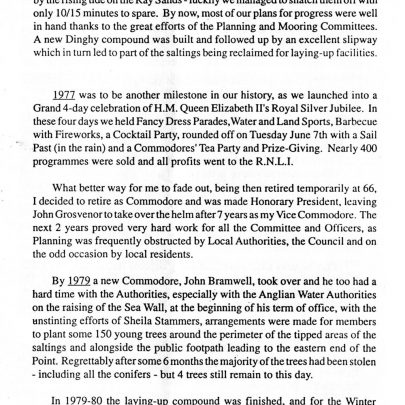
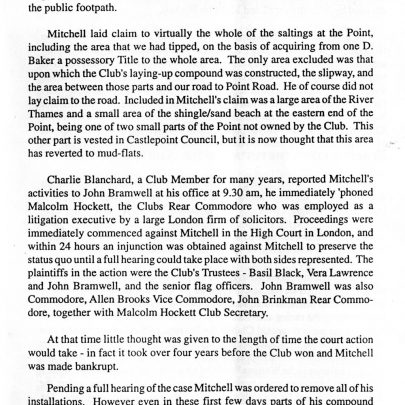
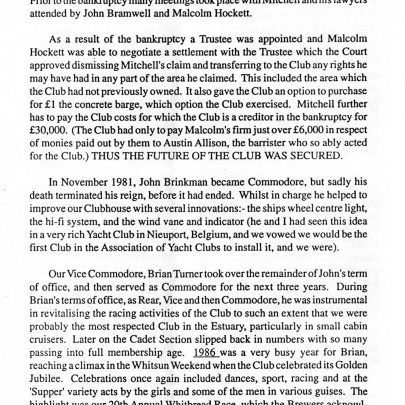
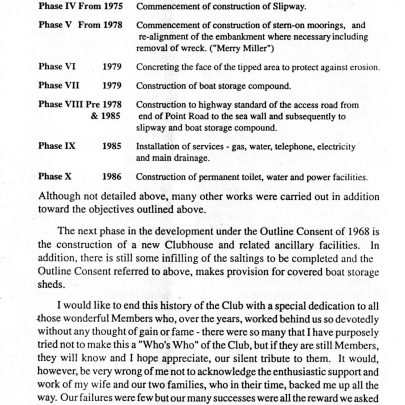




Comments about this page
I never knew that the Government were thinking of damming the Creek well before the floods. When was Sunnyside Hotel built as it’s described as new in 1948 and became the Convent around 1949/50.
Maureen I have just re-read the passage and I may be wrong but I cannot see where it says the Sunnyside Hotel was new. The Sunnyside Hotel started after the war using what was the original Anglican Convent buildings.
Add a comment about this page